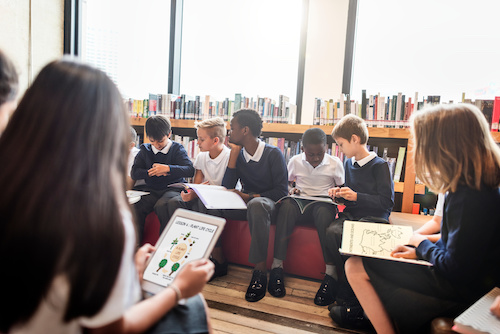Key points:
- Interactive whiteboards, tablets, immersive tools, and more are all valuable
- Learn more about technology tools used in teaching and learning
- Stay up-to-date on all things concerning learning in the digital age
Technology plays a pivotal role in transforming K-12 teaching and learning in the digital age, offering innovative tools that enhance engagement, personalization, and efficiency. From interactive apps to virtual environments, these technologies create dynamic educational experiences, preparing students for the demands of the digital age while empowering educators to deliver impactful lessons.
How technology helps in teaching and learning
Technology revolutionizes K-12 teaching and learning, offering myriad benefits. Types of technology used in education include interactive whiteboards, educational apps, and online resources engage students with dynamic content, fostering better understanding. Learning management systems streamline administrative tasks, allowing educators to organize, distribute, and assess coursework efficiently. Virtual reality and simulations transport students to immersive educational environments, enhancing experiential learning. Adaptive learning platforms tailor instruction to individual needs, promoting personalized learning experiences. Collaboration tools facilitate real-time communication and teamwork, essential skills in a digital world.
Moreover, technology provides instant access to a wealth of information, cultivating digital literacy. By embracing these tools, K-12 education transcends traditional boundaries, creating versatile, inclusive, and future-ready learning environments that prepare students for success in an increasingly technology-driven society.
What is an example of technology as a learning tool?
Among technology tools used in the classroom, one strong example is the use of educational robotics kits, such as LEGO Mindstorms. These kits combine physical building elements with programmable components, allowing students to design, build, and program robots. This hands-on approach integrates science, technology, engineering, and mathematics (STEM) concepts, promoting problem-solving, creativity, and collaboration. Students not only acquire technical skills in coding and robotics but also develop critical thinking and teamwork abilities.
The interactive and experiential nature of educational robotics enhances engagement, making learning enjoyable and meaningful. By immersing students in real-world applications, this technology tool exemplifies how innovative tools can bridge theoretical knowledge with practical skills, preparing students for the challenges of the future.
Which technology is the most available technology in classrooms?
The most widely available technology in K-12 classrooms is often the use of personal computers or laptops. These devices have become ubiquitous tools for both educators and students, serving various purposes and supporting the importance of technology in the classroom. From accessing educational resources on the internet to running software applications and engaging in online collaboration, personal computers play a central role in modern classrooms.
Additionally, many schools leverage cloud-based platforms and learning management systems to facilitate seamless communication, assignment distribution, and collaboration. The versatility and accessibility of personal computers contribute to their prevalence, making them an integral part of the educational technology landscape in K-12 classrooms. As technology continues to evolve, the integration of personal computing devices remains a fundamental and widely adopted approach to enhancing teaching and learning experiences.
What are the 10 ways to use technology in the classroom?
The use of technology in the classroom to enhance teaching and learning extends throughout classrooms, schools, and districts.
Here are 10 ways to use edtech tools in the classroom:
- Interactive whiteboards: Employ interactive whiteboards to deliver dynamic lessons with multimedia elements, fostering engagement and participation.
- Educational apps: Integrate educational apps across subjects to provide interactive learning experiences, catering to diverse learning styles and enhancing comprehension.
- Learning management systems (LMS): Utilize LMS platforms for efficient organization, distribution of assignments, and real-time tracking of student progress, streamlining administrative tasks.
- Virtual reality (VR): Bring lessons to life through virtual reality, allowing students to explore immersive environments and enhancing understanding in subjects like history, science, and geography.
- Adaptive learning platforms: Implement adaptive learning software to personalize instruction based on individual student needs, ensuring a customized and effective learning path.
- Online collaboration tools: Foster teamwork and communication skills by using online collaboration tools, enabling students to work together on projects and assignments in real-time.
- Digital textbooks: Replace traditional textbooks with digital versions, providing students with interactive and multimedia-rich content while reducing the environmental impact of printed materials.
- Podcasts and multimedia resources: Integrate podcasts and multimedia resources to diversify learning materials, catering to various learning preferences and enhancing engagement.
- Coding and robotics: Introduce coding and robotics programs to promote computational thinking and problem-solving skills, encouraging hands-on, experiential learning.
- Gamification: Incorporate gamified elements into lessons to make learning enjoyable, fostering intrinsic motivation and a sense of accomplishment among students.
Conclusion
The diverse array of technology tools in K-12 classrooms serves as a catalyst for transformative education. From fostering engagement to personalizing learning, these tools empower educators to create dynamic, inclusive environments, preparing students with essential skills for the future in our ever-evolving digital landscape.
- Classroom Learning - April 5, 2024
- Advantages and Disadvantages of Classroom Management - April 5, 2024
- What are Disadvantages of Classroom Management? - April 5, 2024

